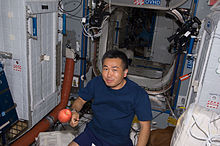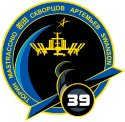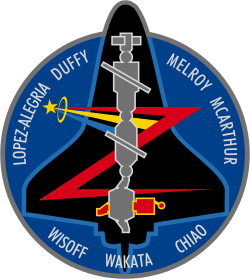Kóiči Wakata
| Kóiči Wakata | |
|---|---|
 | |
| Astronaut JAXA | |
| Státní příslušnost | Japonsko |
| Datum narození | 1. srpna 1963 (61 let) |
| Místo narození | Omija, prefektura Saitama |
| Předchozí zaměstnání | inženýr Japan Airlines |
| Čas ve vesmíru | 504 dní, 18 hodin, 33 minut |
| Kosmonaut od | 28. dubna 1992[1] |
| Mise | STS-72 STS-92/ISS Expedice 18/19/20/(STS-119 ISS/STS-127), Expedice 38/39 (Sojuz TMA-11M/ISS) SpaceX Crew-5/ISS (Expedice 68) |
| Znaky misí | |
| Některá data mohou pocházet z datové položky. | |
Kóiči Wakata (japonsky 若田 光一 [Wakata Kóiči], Hepburnův přepis Kōichi Wakata; * 1. srpna 1963) je japonský astronaut, bývalý zaměstnanec japonské kosmické agentury JAXA, 341. člověk ve vesmíru. V letech 1996 až 2014 uskutečnil čtyři kosmické lety, dva krátkodobé na palubě raketoplánů a dva dlouhodobé pobyty na Mezinárodní vesmírné stanici (ISS). Na ISS se podíval i při svém pátém letu v roce 2022. Ve vesmíru strávil celkem 505 dní. V současnosti pracuje pro společnost Axiom Space.
Život
Inženýr
Vystudoval Kjúšúskou univerzitu (bakalář 1987, magistr 1989). Po škole pracoval v Japonských aeroliniích (JAL, Japan Airlines), zabýval se otázkami předcházení korozi a pevnosti konstrukce letadel.[1]
Astronaut JAXA
V dubnu 1992 byl vybrán mezi astronauty oddílu JAXA. Od srpna 1992 procházel všeobecným výcvikem v Johnsonově středisku NASA v Houstonu. V srpnu 1993 získal kvalifikaci letového specialisty raketoplánu. Poté zůstal v Houstonu ve výpočetním centru oddílu astronautů NASA.[1][2]
1. kosmický let (1996)
V prosinci 1994 byl určen do posádky letu STS-72. Poprvé vzlétl do vesmíru na palubě raketoplánu Endeavour. Let STS-72 trval od 11. do 20. ledna 1996. Wakata obsluhoval kanadskou ruku (RMS), mimo jiné s ní zachytil japonskou družici SFU, kterou raketoplán přivezl zpět na Zem.[3]
2. kosmický let (2000)
V červnu 1997 byl vybrán do posádky letu STS-92. Raketoplán Discovery odstartoval 11. října, přistál 24. října 2000. Programem letu byla dostavba stanice ISS, především instalace nosníku Z1, Wakata opět obsluhoval manipulátor RMS (kanadskou ruku).[2]

3. kosmický let (2009)
Od října 2001 se připravoval na dlouhodobý pobyt na ISS, součástí výcviku byla i stáž v středisku ESA v Kolíně nad Rýnem v srpnu – září 2002 a Středisku přípravy kosmonautů v Hvězdném městečku od prosince 2005.[1] V červenci 2006 byl velitelem posádky pobývající sedm dní v podmořském obydlí NASA u floridského pobřeží.[1][2] V srpnu 2006 byl předběžně určen do Expedice 16 na ISS a zahájil v Rusku přípravu na let Sojuzem, ale za měsíc byl z posádky odvolán.[1] Ve dnech 16. - 27. ledna 2007 absolvoval s Saližanem Šaripovem a Sóičim Nogučim výcvik k přežití v lesích za Moskvou.[1]
13. února 2007 byl určen členem Expedice 18 na ISS. Odstartoval v raketoplánu Discovery 15. března 2009 v letu STS-119. Na ISS zaměnil Sandru Magnusovou. Na přelomu března a dubna Expedici 18 nahradila Expedice 19, Wakata přešel do nové expedice a zůstal na stanici.[1][2] Dne 29. května po příletu dalších tří kosmonautů v Sojuzu TMA-15 se označení posádky stanice změnilo na Expedice 20.[4][5] Dne 17. července 2009 po několikatýdenních odkladech na ISS přiletěl raketoplán Endeavour, který přivezl Wakatova nástupce Timothyho Kopru. Japonský astronaut přestoupil na raketoplán a 31. července přistál na Floridě po 137 dnech, 15 hodinách a 4 minutách letu.[1]
4. kosmický let (2013 – 2014)
V únoru 2011 agentura JAXA oznámila Wakatovo jmenování členem Expedice 38 a velitelem Expedice 39 na stanici ISS, současně byl v záložní posádce Expedice 36/37.[6] Počtvrté do vesmíru a potřetí na ISS odstartoval 7. listopadu 2013 ve funkci palubního inženýra lodi Sojuz TMA-11M, společně s Rusem Michailem Ťurinem a Američanem Richardem Mastracchio, po šestihodinovém letu se Sojuz se spojil se stanicí. Na ISS pracoval jako palubní inženýr osmatřicáté expedice, od března 2014 se stal velitelem devětatřicáté expedice[7] a současně prvním japonským velitelem ISS.[6] V pořádku se vrátil na Zem 14. května 2014.
5. kosmický let (2022 – 2023)
V říjnu 2021 byla oznámena[8] nominace Kóiči Wakaty do posádky letu SpaceX Crew-5, tedy současně i Expedice 68. Ke svému pátému letu odstartoval 5. října 2022[9] ve funkci letového specialisty a stal se jedním z malé skupinky astronautů, kteří letěli do kosmu ve třech různých kosmických lodích. Během letu mimo jiné absolvoval svůj první výstup do volného prostoru – 20. ledna 2023 během 7 hodin a 21 minut spolu s astronautkou Nicole Mannovou na příhradovém nosníku montovali a propojovali montážní platformy pro instalaci dvou solárních polí iROSA.[10][11] Svou práci dokončili při dalším výstupu 2. února 2023, který trval 6 hodin a 41 minut.[12] Celková doba Wakatových výstupů do volného prostoru se tak zvýšila na 14 hodin a 2 minuty. Ze stanice ve své lodi odletěl 11. března 2023 a přistál 12. března 2023[13] po 157 dnech, 10 hodinách a 1 minutě letu.
Astronaut a manažer Axiom Space
Agentura JAXA pár dní před koncem března 2024 oznámila Wakatův odchod z oddílu astronautů i z agentury k poslednímu dní měsíce.[14] Jen o několik dní později informovala společnost Axiom Space, že se Wakata stal jejím astronautem a technickým ředitelem pro asijsko-pacifický region.[15] Zařadil se do skupiny profesionálních velitelů budoucích soukromých vesmírných misí a bude podporovat expanzi obchodní a strategické přítomnosti Axiom Space v regionu navazováním partnerství a dohod, prezentací projektu a při dalších příležitostech.[16]
Osobní život
Kóiči Wakata je ženatý, manželka je Němka Stefanie von Sachsen-Altenburg z Bonnu, mají syna.[1]
Reference
- ↑ a b c d e f g h i j IVANOV, Ivan, a kol. Космическая энциклопедия ASTROnote [online]. [cit. 2009-03-31]. Kapitola Koichi Wakata. Dostupné online. (rusky)
- ↑ a b c d JAXA. International Space Station [online]. Japan Aerospace Exploration Agency, rev. 2013-5-29 [cit. 2014-03-18]. Kapitola Koichi Wakata (Dr. Eng.). Dostupné online. (anglicky)
- ↑ VÍTEK, Antonín; KRUPIČKA, Josef. Dvě družice a dva výstupy. Letectví a kosmonautika. 1997, čís. 2. Dostupné online.
- ↑ HOLUB, Aleš. MEK. Malá encyklopedie kosmonautiky [online]. [cit. 2009-05-29]. Kapitola Sojuz TMA-15. Dostupné online.
- ↑ Expedition 20 Crew Docks with Space Station [online]. NASA, 2009-5-29 [cit. 2009-05-29]. Dostupné v archivu pořízeném dne 2013-04-08. (anglicky)
- ↑ a b Astronaut Koichi Wakata Selected as Member of ISS Expedition Crew [online]. JAXA, 2011-2-17 [cit. 2011-02-22]. Dostupné v archivu pořízeném dne 2011-02-20. (anglicky)
- ↑ RKK Eněrgija. Экспедиция МКС-38/39 [online]. Koroljov: RKK Eněrgija [cit. 2014-03-18]. Dostupné v archivu pořízeném dne 2013-11-09. (rusky)
- ↑ JAXA | Announcement of the Space Vehicle for JAXA Astronaut Koichi Wakata’s International Space Station (ISS) Expedition. JAXA | Japan Aerospace Exploration Agency [online]. [cit. 2021-11-06]. Dostupné online. (anglicky)
- ↑ DINNER, Josh. SpaceX launches Crew-5 astronauts on historic flight to space station for NASA. Space.com [online]. 2022-10-05 [cit. 2022-10-05]. Dostupné online. (anglicky)
- ↑ LAVELLE, Author Heidi. Astronauts Begin Spacewalk to Prep for Station Power Upgrades. blogs.nasa.gov [online]. [cit. 2023-01-21]. Dostupné online. (anglicky)
- ↑ GARCIA, Author Mark. Spacewalkers Wrap Up First Spacewalk of 2023. blogs.nasa.gov [online]. [cit. 2023-01-21]. Dostupné online. (anglicky)
- ↑ GARCIA, Author Mark. Spacewalkers Complete Construction Job to Upgrade Station Power. blogs.nasa.gov [online]. [cit. 2023-02-04]. Dostupné online. (anglicky)
- ↑ DINNER, Josh. SpaceX Dragon capsule splashes down with Crew-5 astronauts after 157 days in space. Space.com [online]. 2023-03-12 [cit. 2023-03-12]. Dostupné online. (anglicky)
- ↑ Japanese astronaut Wakata Koichi to retire from JAXA at end of March | NHK WORLD-JAPAN News. NHK WORLD [online]. [cit. 2024-04-19]. Dostupné online. (anglicky)
- ↑ Japanese Astronaut Koichi Wakata Joins Axiom Space. Axiom Space [online]. 2024-04-08 [cit. 2024-04-19]. Dostupné online. (anglicky)
- ↑ Axiom Space. In his new role as Astronaut and CTO for the Asia-Pacific region, @Astro_Wakata will help drive the expansion of Axiom Space's business & strategic presence in the region by facilitating partnerships, agreements, introductions, and other opportunities.. X.com [online]. 2024-04-17 [cit. 2024-05-05]. Dostupné online.
Externí odkazy
 Obrázky, zvuky či videa k tématu Kóiči Wakata na Wikimedia Commons
Obrázky, zvuky či videa k tématu Kóiči Wakata na Wikimedia Commons - JAXA. International Space Station [online]. Japan Aerospace Exploration Agency, rev. 2013-5-29 [cit. 2014-03-18]. Kapitola Koichi Wakata (Dr. Eng.). Životopis na stránkách japonské kosmické agentury JAXA. Dostupné online. (anglicky)
- O Sojuzu TMA-11M na webu MEK-Kosmo
- @Astro_Wakata – osobní účet na platformě X
Média použitá na této stránce
Japan Aerospace Exploration Agency (JAXA) astronaut Koichi Wakata, flight engineer
The Expedition 20 patch symbolizes a new era in space exploration with the first six-person crew living and working onboard ISS and represents the significance of the ISS to the exploration goals of NASA and its international partners. The six gold stars signify the men and women of the crew. The astronaut symbol extends from the base of the patch to the star at the top to represent the international team, both on the ground and on orbit, that are working together to further our knowledge of living and working in space. The space station in the foreground represents where we are now and the important role it is playing towards meeting our exploration goals. The knowledge and expertise developed from these advancements will enable us to once again leave low earth orbit for the new challenges of establishing a permanent presence on the moon and then on to Mars. The blue, gray and red arcs represent our exploration goals as symbols of Earth, the moon and Mars.
A fire-breathing, five-shaped dragon propels the Crew Dragon spacecraft of NASA's SpaceX Crew-5 mission beyond the confines of a pentagon’s outline and into low-Earth orbit. As the spacecraft ascends above the Earth’s atmosphere and its crew of courageous explorers embarks on their expedition aboard the International Space Station, the dragon’s fire transitions to the colors of NASA’s Commercial Crew Program representing the unrelenting efforts of the many teams who have met this challenge with unparalleled determination. The sun shines its light on this international team as they bravely pursue.
Expedition 19 marks the final planned period of three person occupancy, prior to increasing the crew size to 6, and occurs in the final stages of International Space Station assembly. The patch emphasizes the earth, one of the major focuses of attention and study from the orbital research outpost. The design is stylized to highlight the beauty of the home planet and the station orbiting it, next to the sun now the unquestioned 'brightest star in the sky' as viewed from earth.
ISS Expedition 38 Patch
As the International Space Station (ISS) has become a stepping stone to future space exploration, the Expedition 38 mission patch design paints a visual roadmap of exploration beyond low Earth orbit, most prominently represented by the design's flowing Expedition 38 mission numbers that wrap around Earth, the moon and Mars. Just as the sun is a guiding light in the galaxy, the ISS illuminates the bottom of the design as it is a shining beacon of the advancement of science, knowledge, and technology carried out aboard the Space Station. To visually capture the idea of the ISS being a foundation for infinite discovery, the space station's iconic solar arrays span upwards, providing the number 38 and its exploration roadmap a symbolic pedestal to rest on. Finally, the overall use of red, white, and blue in the design acknowledges the flags of the countries of origin for Expedition 38's crew -- the United States, Russia, and Japan.
ISS Expedition 39 Patch
Increment 39 of the International Space Station Program marks the 15th year of operation since the start of the space laboratory assembly. Today, the U.S., Russia, Japan, Canada and the European Space Agency are partnering in the operation of the largest ever orbital outpost managed by humankind. The names of the six crew members are depicted in their native languages. For Expedition 39, the Soyuz spacecraft serves as transport vehicle for the crew members to and from the station. During this expedition, the ISS will serve as a platform for scientific research, Earth and astronomical observation, education, as well as a stage for the development of new technologies used for the exploration beyond low Earth orbit. The star above the complex signifies human space exploration towards new frontiers. The crew members added these words: "The crew of Expedition 39 is proud to serve the international community in furthering our scientific knowledge and in expanding human presence in space."
Japan Aerospace Exploration Agency's Koichi Wakata, pictured here on the International Space Station, changes over from STS-119 mission specialist to an ISS flight engineer for a tour aboard the orbital outpost.
Space Shuttle mission STS-127 is the 32nd construction flight of the International Space Station (ISS) and the final of a series of three flights dedicated to the assembly of the Japanese "Kibo" laboratory complex. In addition to delivering, installing, and servicing an external scientific platform that will be attached to the end of the Japanese module, STS-127 will bring up a new ISS crew member and return another one to Earth, replace vital components of the ISS electrical production system, and transfer various pieces of hardware to ISS. Five spacewalks and the operation of four different robotic arms will be required to accomplish these tasks over 10 days. A crew spokesperson had the following words for the patch. "Bathed in sunlight, the blue Earth is represented without boundaries to remind us that we all share this world. In the center, the golden flight path of the space shuttle turns into the three distinctive rays of the astronaut symbol culminating in the star-like emblem characteristic of the Japanese Space Agency, yet soaring further into space as it paves the way for future voyages and discoveries for all humankind."
Designed by the crew members, the STS-92 patch symbolizes the second mission to carry U.S.-built elements to the International Space Station (ISS) for assembly. The black silhouette of the Space Shuttle Discovery stands out against the deep blue background of space in low Earth orbit. In the foreground in gray is a profile view of the ISS as it appears when the shuttle and crew arrive, with the station consisting of the Unity node, its two pressurized mating adapters (PMA), the Zarya functional cargo block, the Zvezda service module, and the Progress cargo vehicle.
Following the shuttle's rendezvous and docking, the ISS configuration will be augmented by the two elements delivered by Discovery–the Z1 truss and PMA-3. These two elements, depicted in red, will be installed using the shuttle's robot arm and be connected to ISS during four spacewalks. The multi-national nature of both the STS-92 crew and the ISS are reflected in the multi-colored Astronaut Office symbol.
ISS Expedition 18 patch
This emblem represents the eighteenth expedition to the International Space Station (ISS). Featured prominently is the Roman numeral XVIII. The "X" evokes exploration, which is at the core of the indivisible cooperation of the International Space Station partners. "V" is for victory and for the five space agencies in the ISS program. "III" stands for the hope that this crew will help evolve the ISS from supporting the last three-person crew to crews of six explorers and researchers. The moon, sun and stars symbolize the efforts of the entire ISS team, which will lead to the human exploration of the moon, our solar system and beyond.
The shape of the STS-119/15A patch comes from the shape of a solar array viewed at an angle. The International Space Station (ISS), which is the destination of the mission, is placed accordingly in the center of the patch just below the gold astronaut symbol. The gold solar array of the ISS highlights the main cargo and task of STS-119/15A -- the installation of the S6 truss segment and deployment of S6's solar arrays, the last to be delivered to the ISS. The surnames of the crew members are denoted on the outer band of the patch. The 17 white stars on the patch represent, in the crew's words, "the enormous sacrifice the crews of Apollo 1, Challenger, and Columbia have given to our space program." The U.S. flag flowing into the space shuttle signifies the support the people of the United States have given our space program over the years, along with pride the U.S. astronauts have in representing the United States on this mission.
STS-72 Mission Insignia
The official insignia of the Expedition 68 mission aboard the International Space Station.
- International Space Station Expedition 68 marks the 24th year of operation since the start of its assembly on orbit. Today, the U.S., Russia, Japan, Canada, and the European Space Agency are partnering in the operation of the largest ever orbital outpost managed by humankind.
- Seven sparkling stars in the vastness of space represent crewmembers and experts on the ground operating the space station. Bright sunbeams illuminate the station, a platform for scientific research, Earth and astronomical observation, education, as well as development of new technologies necessary for the exploration beyond low-Earth orbit, on the Moon and Mars.












